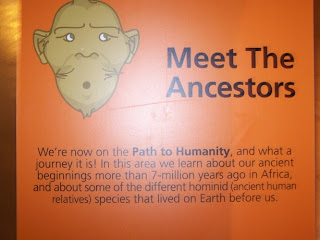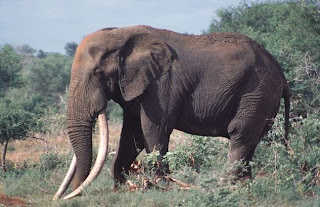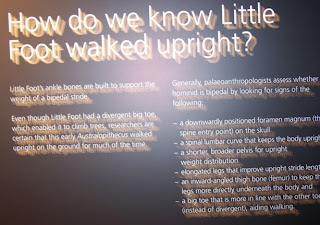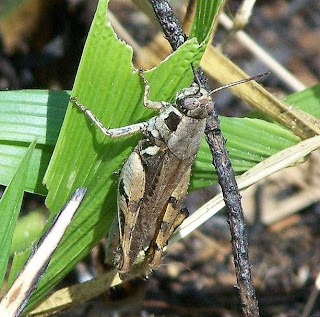About 7-million years ago, early hominids began to adapt to a climate that was cooling globally. Before this, Africa had been mostly covered in rainforest. But as the temperature cooled and dried, savannah replaced the forest. This meant tree-climbing apes had to become more adept at walking on land.
Our ancestors who ventured out into the savannah were rewarded with roots, shrubs and occasional animal carcasses, ensuring that those who walked on two legs were more likely to survive.
 Bipedalism allowed hominids to free their arms, enabling them to make and use tools well, stretch for fruit in trees and use their hands to communicate. They could also see further over the savannah grass.
Bipedalism allowed hominids to free their arms, enabling them to make and use tools well, stretch for fruit in trees and use their hands to communicate. They could also see further over the savannah grass. But even with these advantages, our ancestors probably spent time in trees as well, which we can tell by studying fossils of hands and feet, and how they were adapted to climbing. Although there is a popular idea that our ancestors slouched and stooped forward, the study of fossil hips, spines and feet suggest they always walked fairly upright.
But even with these advantages, our ancestors probably spent time in trees as well, which we can tell by studying fossils of hands and feet, and how they were adapted to climbing. Although there is a popular idea that our ancestors slouched and stooped forward, the study of fossil hips, spines and feet suggest they always walked fairly upright.Our ancestors’ diet changed over time. From eating mostly plants, they began to eat a mixture of meat and protein, along with plant matter. This helped their brains to develop, and in turn altered the shapes of their jaws. Over time, their jaws became less heavy or “robust” and more slender or “gracile”. The jaws of Australopithecus, for example, projected far more forward than ours, but as Homo developed, the jaw moved further back, under the growing braincase. Our teeth also became smaller as we developed the capacity to cut and grind food.
One of the defining characteristics of becoming human has been the growth and development of our brains. Australopithecus had an average cranial (brain) capacity of about 450cc, about the size of an orange. Today, our brains are on average more than three times as big as that, at around 1400cc. But bigger brains don’t necessarily mean a species will survive. Neanderthals had brains on average between about 5% and 10% bigger than ours, and they became extinct about 20,000 years ago.
The oldest stone tools so far dated come from Ethiopia and are about 2.6-million years old. The first technology that our ancestors developed was the Oldowan Industry. These tools were primitive and were mostly just pebbles or broken pebbles. Next, came the Acheulean Industry (pronounced “Eish-oo-lean”). Acheulean tools included large, rough hand-axes and cleavers, probably for chopping and mashing meat. Dozens of Acheulean tools, including hand-axes, have been found right here at Maropeng in an ongoing excavation. The Acheulean was followed by the Middle Stone Age and Later Stone Age, during which tools became much smaller and more refined and were developed for specific tasks, such as skinning an animal, or hafting onto a wooden handle to make a spear. The Later Stone Age in South Africa lasted right up till about 200,000 years ago, and the San people knew how to make these tools right into historical times.
 Control and use of fire
Control and use of fire
The ability to harness and use fire was a major technological step in human development. Our ancestors probably learnt to capture fire from wildfires and keep it burning before they learned to make it. At Swartkrans in the Cradle of Humankind, scientists have found a collection of about 300 bones which have been burnt at a consistent temperature, which is higher than the temperature of the average bushfire. These have been dated to more than 1-million years old.
 Development of language
Development of language
Scientists don’t really know much about this, as our voice-boxes are made of soft tissue, and there is no fossil evidence of how they may have developed over time. Some scientists say we may have acquired the ability to speak at the time of Homo habilis, 2-million years ago, while others say it is only modern Homo sapiens that has been able to speak, within the past 200,000 years ago. Exhibit SK54 is a juvenile cranium of a Paranthropus robustus dated at 1.5 million years discovered in 1949 at Swartkrans by Dr Robert Broom and J.T. Robinson. This specimen possesses two 6mm puncture wounds. Initially it was thought that these fractures were caused by a pointed weapon. Based on subsequent excavations by C.K. Brain the generally accepted theory is that these puncture wounds were caused by a leopard attack. Using another Swartkrans find a lower mandible from an African leopard, C.K. Brain hypothesized that victims wounds were from a predator/prey scenario. The canines of the leopard matched up to the puncture wounds of the skull. An equal distance of 33mm.
Exhibit SK54 is a juvenile cranium of a Paranthropus robustus dated at 1.5 million years discovered in 1949 at Swartkrans by Dr Robert Broom and J.T. Robinson. This specimen possesses two 6mm puncture wounds. Initially it was thought that these fractures were caused by a pointed weapon. Based on subsequent excavations by C.K. Brain the generally accepted theory is that these puncture wounds were caused by a leopard attack. Using another Swartkrans find a lower mandible from an African leopard, C.K. Brain hypothesized that victims wounds were from a predator/prey scenario. The canines of the leopard matched up to the puncture wounds of the skull. An equal distance of 33mm.
 Control and use of fire
Control and use of fireThe ability to harness and use fire was a major technological step in human development. Our ancestors probably learnt to capture fire from wildfires and keep it burning before they learned to make it. At Swartkrans in the Cradle of Humankind, scientists have found a collection of about 300 bones which have been burnt at a consistent temperature, which is higher than the temperature of the average bushfire. These have been dated to more than 1-million years old.
This is the oldest evidence for controlled use of fire in Southern Africa so far, though there is even slightly older evidence of it in East Africa. So we can say South Africa’s first braai happened right here in the Cradle! The ability to control and use fire helped our ancestors to warm themselves and to cook food, thus helping to expand their diets.
 Development of language
Development of languageScientists don’t really know much about this, as our voice-boxes are made of soft tissue, and there is no fossil evidence of how they may have developed over time. Some scientists say we may have acquired the ability to speak at the time of Homo habilis, 2-million years ago, while others say it is only modern Homo sapiens that has been able to speak, within the past 200,000 years ago.
Our sophisticated ability to communicate across time and space sets us apart from other animals, and has helped us to populate the Earth and travel to its most inaccessible regions. It has allowed us to gather food better, to live in groups better, and to express ourselves better.
 Exhibit SK54 is a juvenile cranium of a Paranthropus robustus dated at 1.5 million years discovered in 1949 at Swartkrans by Dr Robert Broom and J.T. Robinson. This specimen possesses two 6mm puncture wounds. Initially it was thought that these fractures were caused by a pointed weapon. Based on subsequent excavations by C.K. Brain the generally accepted theory is that these puncture wounds were caused by a leopard attack. Using another Swartkrans find a lower mandible from an African leopard, C.K. Brain hypothesized that victims wounds were from a predator/prey scenario. The canines of the leopard matched up to the puncture wounds of the skull. An equal distance of 33mm.
Exhibit SK54 is a juvenile cranium of a Paranthropus robustus dated at 1.5 million years discovered in 1949 at Swartkrans by Dr Robert Broom and J.T. Robinson. This specimen possesses two 6mm puncture wounds. Initially it was thought that these fractures were caused by a pointed weapon. Based on subsequent excavations by C.K. Brain the generally accepted theory is that these puncture wounds were caused by a leopard attack. Using another Swartkrans find a lower mandible from an African leopard, C.K. Brain hypothesized that victims wounds were from a predator/prey scenario. The canines of the leopard matched up to the puncture wounds of the skull. An equal distance of 33mm.




 Then I smell it…….the unmistakable smell of elephant! They are so quiet, walking on their toes, that one always smells them first. The giraffe are forgotten and I whip around looking for the elephants. The giraffe flees back to the comfort of mom’s side and I see a small movement behind some bushes. Yes, there he is. A big bull about to pull a branch down off a tree. These mammals must eat in the region of 300kg per day, this includes bark, leaves and grass. What an enormous male he is. I get the camera going. He is about 20 yards away. His tusks are huge and he must be at least in his 60’s. I try to see if he has mates but cannot find another one, but that does not mean they are not there, just that I cannot see them for now. The males are usually loners or with two or three other males. They only join the female herds for mating periods and believe me when I say this is quite a sight to see. On the rare occasions when I have, I actually forgot to take pictures!! He finishes his branch and reaches up for another coming more into the open and closer to the car. I hear something in the bushes on the other side and turn to find another bull not ten yards away coming straight in my direction.
Then I smell it…….the unmistakable smell of elephant! They are so quiet, walking on their toes, that one always smells them first. The giraffe are forgotten and I whip around looking for the elephants. The giraffe flees back to the comfort of mom’s side and I see a small movement behind some bushes. Yes, there he is. A big bull about to pull a branch down off a tree. These mammals must eat in the region of 300kg per day, this includes bark, leaves and grass. What an enormous male he is. I get the camera going. He is about 20 yards away. His tusks are huge and he must be at least in his 60’s. I try to see if he has mates but cannot find another one, but that does not mean they are not there, just that I cannot see them for now. The males are usually loners or with two or three other males. They only join the female herds for mating periods and believe me when I say this is quite a sight to see. On the rare occasions when I have, I actually forgot to take pictures!! He finishes his branch and reaches up for another coming more into the open and closer to the car. I hear something in the bushes on the other side and turn to find another bull not ten yards away coming straight in my direction.

 The first thing I see is impala. They are a medium size antelope and there are about 28,000 of them in the park. They are the favorite prey of cheetah and leopard and it is beneficial to watch the herds as they will give you a good indication if predators are around. The females all gave birth in November and December, so there are plenty of young ones around who are very actively jumping and running around in the cool of morning. Later on, they will be under the trees trying to find a cool shady spot to stay in until the sun goes down. But for now it is amusing to watch their antics. I feel very sorry for the males as they only have a six week period in June/July when they mate with the females, then they run around most of the time chasing other males away and this does not allow them much mating time. However, they seem to get the job done eventually, but by the end of this time, actually have black rings around their eyes from fatigue! What an advantage us two-legged creatures have!
The first thing I see is impala. They are a medium size antelope and there are about 28,000 of them in the park. They are the favorite prey of cheetah and leopard and it is beneficial to watch the herds as they will give you a good indication if predators are around. The females all gave birth in November and December, so there are plenty of young ones around who are very actively jumping and running around in the cool of morning. Later on, they will be under the trees trying to find a cool shady spot to stay in until the sun goes down. But for now it is amusing to watch their antics. I feel very sorry for the males as they only have a six week period in June/July when they mate with the females, then they run around most of the time chasing other males away and this does not allow them much mating time. However, they seem to get the job done eventually, but by the end of this time, actually have black rings around their eyes from fatigue! What an advantage us two-legged creatures have!
 I see beautiful Starlings feeding and come across some ground Hornbills. They are the largest of the hornbill species and stand at about a metre tall. They are black with a bright red crop. The crop is yellow (almost white) when born, turning orange and then red as they grow older. They walk along the road looking for insects, snakes, centipedes and I have even seen them trying to get at a tortoise. Stunning creatures with very long eyelashes, they are wonderful to see.
I see beautiful Starlings feeding and come across some ground Hornbills. They are the largest of the hornbill species and stand at about a metre tall. They are black with a bright red crop. The crop is yellow (almost white) when born, turning orange and then red as they grow older. They walk along the road looking for insects, snakes, centipedes and I have even seen them trying to get at a tortoise. Stunning creatures with very long eyelashes, they are wonderful to see.



























